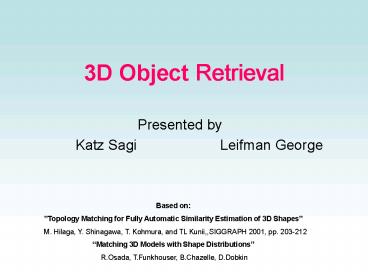3D Object Retrieval - PowerPoint PPT Presentation
1 / 32
Title:
3D Object Retrieval
Description:
When calculating the integral of geodesic distance the computational cost is high ... Appendix- Calculating n. The calculation is done using Dijkstra's algorithm: ... – PowerPoint PPT presentation
Number of Views:46
Avg rating:3.0/5.0
Title: 3D Object Retrieval
1
3D Object Retrieval
- Presented by
- Katz Sagi Leifman George
Based on Topology Matching for Fully Automatic
Similarity Estimation of 3D Shapes M. Hilaga,
Y. Shinagawa, T. Kohmura, and TL Kunii,,SIGGRAPH
2001, pp. 203-212 Matching 3D Models with Shape
Distributions R.Osada, T.Funkhouser,
B.Chazelle, D.Dobkin
2
3D Objects Retrieval Why?
- Improved modeling tools
- Improved scanning devices
- Fast and cheap CPUs, Gfx HW
- Large databases
- E-commerce
- Medicine
- Entertainment
- Molecular biology
- Manufacturing
3
3D vs. 2D Retrieval
- 2D
- Object Boundaries
- Features Occlusion
- Camera dependent
- Noise
- Simple Contour representation
- 3D
- Problematic Surface Representation
- Ambiguous Triangulation
- No Features Occlusion, shadows, noise
4
Common Approach
- Preprocess Stage
- Objects Normalization (optional)
- Signature for each object
- Compact
- Capture the object properties
- Comparable
- Signature Comparison
- Coarse-to-Fine (optional)
- Fast
DB
Object signatures
Signatures Comparison
Queryprocess
Query
Similarobjects
Object
5
Signature Properties
- What do we want from good signature?
- Robustness to resampling and simplification
- Translation, Orientation, Scale Invariance
- Possible Solutions
- Preprocess Object Normalization
- Automatically embedded in the key by definition
6
Object Normalization using Moments
Translation (m100, m010, m001) center of mass
Rotation, Scale
?(1,1) - main axis scale U Rotation Matrix
7
Different Methods
- Octrees
- Probability Shape Distributions
- Distances to Enclosing Sphere
- Reeb Graphs
8
Octrees
- Signature
- Each object is represented by Octree
- White, black, gray (gray level)
- Signature Comparison
- Coarse-to-Fine search (tree depth)
9
Probability Shape Distributions
- Several types of signatures
- A3 angle between three random surface points
- D1 distance from fixed point to random point
- D2 distance between two random surface points
X-axis D2 distance Y-axis Probability of that
distance
Signature Comparison L1,L2,L8 for PDF and CDF
10
Distances to Enclosing Sphere
- Signature
- Sphere is evenly sampled
- For each sphere sample min. distance to object
calculated
Signature Comparison L1,L2,L8
11
Topology MatchingUsing MRGs
12
The Idea
- The signature
- Multiresolutional Reeb Graphs (MRGs)
- Represents the skeletal and topological structure
of a 3D shape at various levels of resolution - Constructed using a continuous function on the 3D
shape. - Correspondence between the parts of objects.
- Invariant to transformations and non-rigid
deformations - The search
- coarse to fine
13
How to Reeb an Object
- Well create a simple reeb graph using height
function - µ - height of the point V µ(V(x,y,z))z
14
MultiResolutional Reeb Graph(MRG)
- A series of Reeb graphs at various levels of
detail
15
The Construction of the MRG
- Define the following notation
- R-node A node in an MRG.
- R-edge An edge connecting R-nodes in an MRG.
- T-set A connected component of triangles in a
region - µn -range A range of the function µn concerning
an R-node or a T-set.
16
The Construction of the MRG cont.
- The domain of µn is divided onto K µn-ranges
- R00,1/K),R11/k,2/k).Rk-1(K-1)/K,1)
- Note The example uses the height function for
the convenience of explanation
17
The Construction of the MRG cont.
- Subdivision
- Interpolate the position of two relevant vertices
in the same proportion as their value of µn(v)
18
The Construction of the MRG cont.
- Calculate T-sets
- Connect R-nodes
19
The Construction of the MRG cont.
- Construct MRG
- fine-to-coarse (reverse)
20
Defining µ for Topology Matching
- Height function is not appropriate
- not invariant to transformations.
- Use a geodesic distance
- Not invariant to scale
- Normalize 0,1
21
Examples of the Distribution of the Function µ
- More asymmetric shapes have a wider range for
µn(v) - Sphere
- constant value of µn(v)0
22
Matching
- Assign 2 attributes for each node (m) in the
finest resolution - Area
- Length
23
Matching cont.
- Define
- At coarse resolution
- Similarity (0ltwlt1)
- To satisfy
- Define
24
Matching cont.
25
Topology Matching Added Value
- Topology matching
- can be used to find
- correspondence
- between meshes
- Problem
- The algorithm does
- Not distinguish between
- Left and right
26
Results
- 230 mesh objects
27
Future Work
- Use additional information
- Texture,color,curvature etc.
- Euclidean distance as the R-node attribute
- Use different µ functions
- Density for volumetric data
28
Summary
29
END
30
Appendix- MRG Construction
- When calculating the integral of geodesic
distance the computational cost is high - We employ a relatively simple method in which
geodesic distance is approximated by Dijkstras
algorithm based on edge length. - We need to prepare the mesh for this approximation
31
Appendix- Preparing the Mesh
- The distribution of the vertices should be fine
enough to represent the function µn(v) well. - We need to resample the vertices until all edge
length are less than a threshold p - If edges of a mesh are uniform in a certain
direction, the accuracy of the calculation of µ
(v) is biased and results in an inaccurate
calculation of µn(v) - Special edges called short-cut edges may need
to be added to the mesh to modify the uniformity
by making the directions of edges isotropic. - The algorithm for adding a short-cut edge
- t1,t2 and t3 which are adjacent to the triangle
tc are unfolded on the plane of tc - New edges are generated between each of the
vertex pairs but only if an edge is inside the
unfolded polygon
32
Appendix- Calculating µn
- The calculation is done using Dijkstras
algorithm































